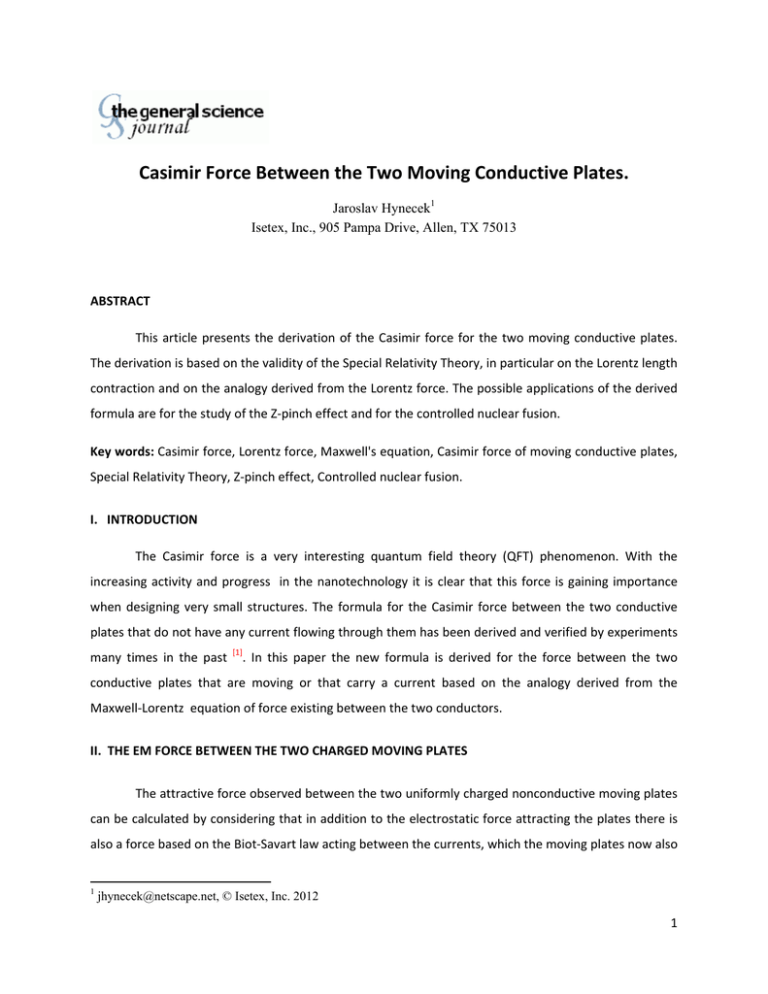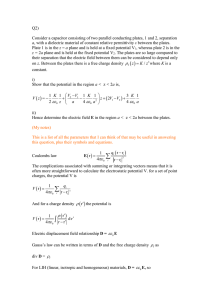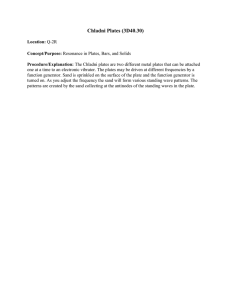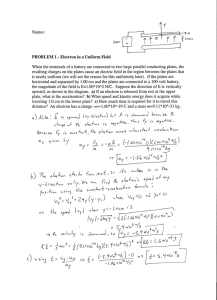Casimir Force Between the Two Moving Conductive Plates.
advertisement

Casimir Force Between the Two Moving Conductive Plates. Jaroslav Hynecek1 Isetex, Inc., 905 Pampa Drive, Allen, TX 75013 ABSTRACT This article presents the derivation of the Casimir force for the two moving conductive plates. The derivation is based on the validity of the Special Relativity Theory, in particular on the Lorentz length contraction and on the analogy derived from the Lorentz force. The possible applications of the derived formula are for the study of the Z‐pinch effect and for the controlled nuclear fusion. Key words: Casimir force, Lorentz force, Maxwell's equation, Casimir force of moving conductive plates, Special Relativity Theory, Z‐pinch effect, Controlled nuclear fusion. I. INTRODUCTION The Casimir force is a very interesting quantum field theory (QFT) phenomenon. With the increasing activity and progress in the nanotechnology it is clear that this force is gaining importance when designing very small structures. The formula for the Casimir force between the two conductive plates that do not have any current flowing through them has been derived and verified by experiments many times in the past [1]. In this paper the new formula is derived for the force between the two conductive plates that are moving or that carry a current based on the analogy derived from the Maxwell‐Lorentz equation of force existing between the two conductors. II. THE EM FORCE BETWEEN THE TWO CHARGED MOVING PLATES The attractive force observed between the two uniformly charged nonconductive moving plates can be calculated by considering that in addition to the electrostatic force attracting the plates there is also a force based on the Biot‐Savart law acting between the currents, which the moving plates now also 1 jhynecek@netscape.net, © Isetex, Inc. 2012 1 represent. To calculate this force it is useful to first find the magnetic field H existing in the space between the plates. For the selected configuration the simplest way is to use the integral form of Maxwell’s equation: H ds I , (1) where the integration path and the current flow are illustrated in a drawing in Fig.1. The magnetic field intensity between the plates up to their internal surfaces is thus equal to: Q v . L( v )W H Similarly for the electric field from the Gauss law it is: 0 E dS Q , (2) (3) where the integrating surface S encloses one of the plates. For the field magnitude then follows that: E Q . 0 L( v )W (4) Both, the magnetic field as well as the electric field intensities are, of course, zero on the external surfaces of the plates, but through the plate’s thickness increase linearly from zero to the full value found between the plates. This is the consequence of the assumption that the embedded charge distribution within the plates’ volume is uniform. The formula for the force is obtained from the Lorentz force equation: Fq Q E v B , (5) (6) which must be integrated over the plate’s thickness z p . Fq Q 0 L(v)W z v2 p z Q 1 2 dz . c 0 zp zp After completion of integration in Eq.6 where the substitutions for the parameters: B 0 H , and 0 0 1 / c 2 were also made, the result becomes: Fq Q2 2 0 L(v)W v2 1 2 . c (7) The potential energy of this arrangement is then calculated by integrating the force over the distance between the plates and including the Lorentz length contraction factor: L(v) L0 1 v 2 / c 2 . The result is: 2 Q2d0 m0 v 2 2 2 Wq|| 1 v / c . 2 0 A0 1 v2 / c2 (8) In this formula the subscripts zero indicate the laboratory stationary values. To determine the total energy the velocity dependent integration constant has also been added to this expression to make the energy consistent with the formula: Wq|| m0 c 2 / 1 v 2 / c 2 . The important point to note, however, is that the energy does not change when this arrangement is moving in the z direction perpendicular to the plates. The current does not flow for the perpendicular motion and the plate's area A0 is not contracted, but the spacing between the plates is shortened by the Lorentz contraction factor. Therefore, it follows that for the motion parallel to the plates and perpendicular to the plates it is: Wq|| Wq (9) Finally it is necessary to comment also on the force direction and thus on the sign of the energy. When the current flows in the same direction for the insulating plates charged by the same charge, the electrostatic force between the plates is repulsive, but the Lorentz component is attractive. When the plates are conductive and charged it will be assumed that the result is the same as for the insulating plates, except for the fact that charge will reside entirely on the inner surfaces of the plates. +mq I s d v -mq v H I zp E W L(v) Fig.1. Orientation of current I generated by the moving charged plates and orientation of the resulting electric and magnetic fields. Charge Q mq . The magnetic field integration path s used in Eq.1 is also indicated. 3 II. THE CASIMIR FORCE AND THE CASIMIR POTENTIAL The Casimir force [1,2] is an interesting QFT phenomenon. The QFT provides the formula for the force between the two stationary conductive plates and thus the corresponding potential as follows: Wc|| hc A0 . 1440 d 03 (10) For the moving plates oriented as in Fig.1 it is reasonable to anticipate the following modification: Wc|| m0 v 2 hc 2 2 A v c f v 1 / ( ) 0 1440 d 03 1 v2 / c2 3/ 2 , (11) where a velocity depended factor f (v) and the velocity dependent integration constant were included similarly as in the previous case of the total energy appearing in Eq.(8). It will be further assumed that the energy will again be independent of the motion direction as in Eq. (9) and, therefore, for the total energy in the perpendicular motion direction it should hold that: Wc A0 hc 3 1440 d 0 1 v 2 / c 2 3/ 2 m0 v 2 1 v 2 / c2 . (12) 3/ 2 By comparing these two formulas the velocity dependent factor f (v) can be determined. f (v) 1 v 1 2 / c2 2 . (13) From this result then follows that the Casimir force for the moving conductive plates is: Fc|| A0 hc 4 2 480d 0 1 v / c 2 . (14) This is an interesting result that could possibly be experimentally verified. This result also 3/ 2 presents a considerable challenge to the QMT theoreticians, since the theory should provide its fundamental justification [3,4,5,6]. The result is interesting also from the point of view of experimental confirmation of the Lorentz length contraction. The very close parallel sheets of moving conductors or a very dense ionized plasma current sheets should thus attract each other by a much stronger force than the usual Lorentz force suggests. This may have a significant consequences for the studies of the Z‐pinch where the attempts are being made to achieve a controlled nuclear fusion. 4 III. CONCLUSIONS In this article the Casimir force between the two moving conductive plates and therefore between the two current sheets was derived. It is suggested that this force is stronger than the usual Lorentz force thus having significant consequences for the Z‐pinch and the study of the controlled nuclear fusion. The study of the motion dependence of the Casimir force could thus provide additional insights into the nuclear fusion problems. REFERENCES 1. http://en.wikipedia.org/wiki/Casimir_effect 2. http://prd.aps.org/abstract/PRD/v65/i12/e125005 3. T.G. Philbin, U. Leonhardt, "Casimir‐Lifshitz force between moving plates at different temperatures", arXiv:0904.2148v3 [quant‐ph] 11 May 2009. 4. M. Tajmar, "Finite‐Element Simulation of Casimir Force in Arbitrary Geometries", http://arxiv.org/ftp/quant‐ph/papers/0405/0405015.pdf 5. Anushree Roy, U. Mohideen, "A verification of Quantum field theory‐measurement of Casimir force", Paramana‐journal of physics, Indian Academy of Sciences Vol. 56, Nos 2&3 Feb. & Mar. 2001 pp. 239‐243. 6. M. Bordag, U. Mohideen, V.M. Mostepanenko, "New Developments in the Casimir Effect", Elsevier, Physics Reports 353 Amsterdam, 2001 pp. 1‐205. 5




